The grass Tuctoria mucronata, which is known by several common names including prickly spiralgrass, Solano grass, and Crampton's tuctoria, is a federally listed endangered plant species endemic to two counties in northern California.
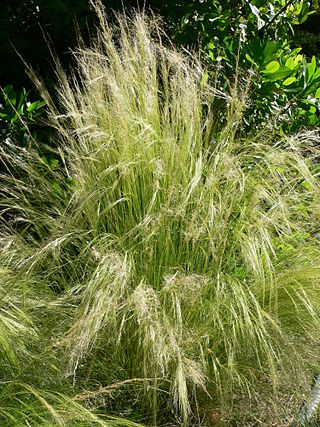
Nassella, or needlegrass, is a New World genus of over 100 perennial bunchgrasses found from North America through South America. The Latin word nassa refers to "a basket with a narrow neck". It is usually considered segregate from the genus Stipa and includes many New World species formerly classified in that genus. As of 2011, The Jepson Manual includes Nassella within Stipa.
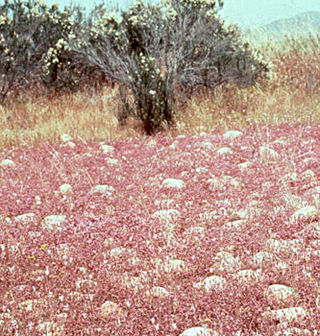
Pogogyne is a small genus of flowering plants in the mint family known generally as mesamints or mesa mints. They are native to Oregon, Idaho, California, and Baja California.

Swallenia is a rare genus of plants in the grass family, found only in Death Valley National Park, California.

Tuctoria greenei is a species of grass endemic to California. Its common names include awnless spiralgrass and Greene's tuctoria. It is included by the California Native Plant Society on list 1B.1. It is also listed by the state of California as rare and by the Federal Government as endangered, having been federally listed on March 26, 1997.

Eriocoma latiglumis is a species of grass known by the common names wide-glumed needlegrass and Sierra needlegrass.
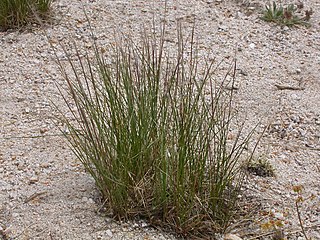
Eriocoma occidentalis is a species of grass known by the common name western needlegrass. It is native to western North America from British Columbia to California, Colorado, and Arizona and in northeastern Mexico (Chihuahua), where it grows in many types of habitat.
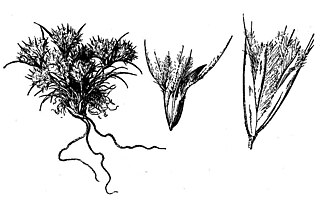
Blepharidachne kingii is a species of grass known by the common name King's eyelashgrass. It is native to the Great Basin in the United States, where it grows in habitat such as pinyon-juniper woodland. It is rare in California and Idaho, but it is one of the most common grasses of the northeastern deserts of Nevada.
Eryngium pinnatisectum is an uncommon species of flowering plant in the family Apiaceae, known by the common names Tuolumne eryngo and Tuolumne button celery.
Eryngium racemosum is a rare species of flowering plant in the family Apiaceae known by the common name delta eryngo, or delta button celery.
Juncus triformis is an uncommon species of rush known by the common names Yosemite dwarf rush and long-styled dwarf rush.

Lomatium caruifolium, known by the common name alkali desertparsley, is a species of flowering plant in the carrot family.

Tuctoria is a genus of three species of grass in the family Poaceae. Spiralgrass is a common name for plants in this genus. These are bunchgrass species that are found in vernal pools of central California and Baja California, Mexico. The plants are annuals that germinate under water in the spring and grow submerged for weeks. After the pools dry down, the grasses initiate a new set of foliage that lasts for one to two months until flowering and fruiting are complete.
Orcuttia inaequalis is a rare species of grass known by the common name San Joaquin Valley Orcutt grass.
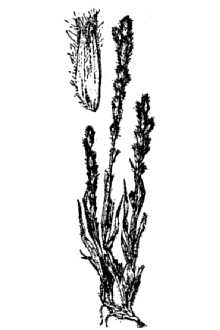
Orcuttia pilosa is a rare species of grass known by the common name hairy Orcutt grass.
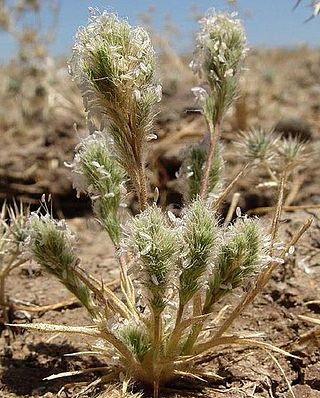
Orcuttia viscida is a rare species of grass known by the common name Sacramento Orcutt grass.
Carlquistia is a rare North American genus of flowering plants in the family Asteraceae containing the single species Carlquistia muirii. Formerly named Raillardiopsis muirii, the plant was reexamined in the 1990s and moved to a new genus of its own, separate from similar and closely related genera, such as Madia. Common names for the species include Muir's tarplant, Muir's raillardiopsis, and Muir's raillardella.

Sidalcea calycosa is a species of flowering plant in the mallow family known by the common names annual checkerbloom, checker mallow, and vernal pool checkerbloom.
Trifolium bolanderi is a species of clover known by the common names Bolander's clover and parasol clover.
Navarretia ojaiensis is a rare species of flowering plant in the phlox family known by the common name Ojai navarretia.












